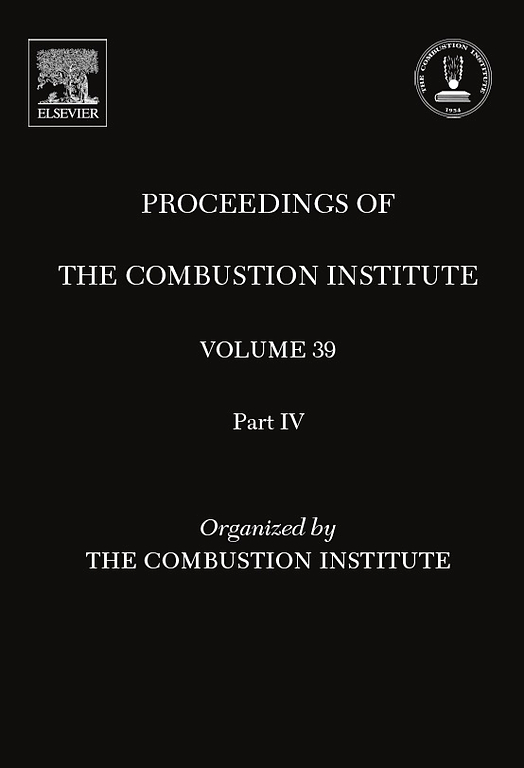探索漩涡强度对非预混 NH3/CH4 漩涡火焰的稳定性、排放和火焰结构的影响
IF 5.3
2区 工程技术
Q2 ENERGY & FUELS
引用次数: 0
摘要
氨作为一种清洁的无碳燃料,其低反应性和高氮氧化物排放量使其吸引力大打折扣,限制了其实际应用。了解漩涡强度对氨火焰稳定和排放的影响仍然是一个空白。本研究试图探索漩涡强度对稳定、NO/NH 排放以及非预混合 NH/CH 漩涡火焰中 NO 和 OH 自由基空间分布的影响。燃烧器由中心燃料喷射(燃料喷射速度为 U)和漩涡气流(气流速度为 U)组成。氨分子分数(:0 至 0.85)的 NH/CH 混合物被提供给中央射流。通过比较 U 与 U 的稳定性图可以发现,在相同的漩涡数(S)下,随着 U 的增加,熄灭火焰所需的 U 越高,同时,较高的水平放大了 U 对 U 的敏感性。然而,S 的影响随着 S 的增加而减小,直到 = 0.85 时才开始不利地降低喷火极限。在 ≥ 0.75 时,在增加 S 的同时,将 Φ(全局混合物当量比)调整为化学计量,可有效降低 NO 排放量并限制 NH 滑入排气管。OH/NO-PLIF 测量结果突出显示了燃烧器出口附近的锥形 OH/NO 层。锥形 NO 层转变为更宽广、更均匀的下游,该区域内的 NO 强度可能反映了排气中测得的 NO 水平。在低 S 条件下,火焰温度升高会拉长 OH/NO 结构,并加剧下游距离的 NO 梯度。相反,S 的增加会加强燃料/空气的混合,并减弱增加和 Φ 对火焰结构的影响。随着 S 的增加,NO 排放对 Φ 的敏感性也会降低。本文章由计算机程序翻译,如有差异,请以英文原文为准。
Exploring the influence of swirl intensity on stability, emissions, and flame structure in non-premixed NH3/CH4 swirling flames
Ammonia's appeal as a clean, carbon-free fuel is marred by its low reactivity and high NOx emissions, limiting its practical use. Understanding swirl intensity's influence on ammonia flame stabilization and emissions remains a gap. This study endeavors to explore the impact of swirl intensity on stabilization, NO/NH emissions, and the spatial distribution of NO and OH radicals in non-premixed NH/CH swirling flames. The burner consists of a central fuel jet (with a fuel jet velocity, U) surrounded by swirling airflow (of an air velocity, U). A blend of NH/CH, with ammonia mole fraction (: 0 to 0.85), was supplied to the central jet. The stability map, comparing U versus U, revealed that at the same swirl number (S), as U increased, a higher U became necessary to extinguish the flame, while, the higher levels amplified the sensitivity of U to U. For ≤ 0.25, an increase in S elevated the U required for the flame to blowout. However, this impact of S diminishes as increases until it starts to adversely reduce the blowout limits at = 0.85. At ≥ 0.75, adjusting Φ (the global mixture equivalence ratio) towards stoichiometry alongside increased S effectively lowers NO emissions and limits NH slip into the exhaust. The OH/NO-PLIF measurements highlight conical OH/NO layers near the burner exit. This conical NO layer transforms into a broader and more uniformly downstream, where the intensity of NO within this area likely mirrors the NO levels measured in the exhaust. Increasing at low S flames elongates both the OH/NO structure and intensifies the NO gradient in downstream distances. Conversely, an increase in S enhances fuel/air mixing and diminishes the impact of increased and Φ on the flame structure. A reduced sensitivity of NO emissions to Φ is observed with increasing S.
求助全文
通过发布文献求助,成功后即可免费获取论文全文。
去求助
来源期刊

Proceedings of the Combustion Institute
工程技术-工程:化工
CiteScore
7.00
自引率
0.00%
发文量
420
审稿时长
3.0 months
期刊介绍:
The Proceedings of the Combustion Institute contains forefront contributions in fundamentals and applications of combustion science. For more than 50 years, the Combustion Institute has served as the peak international society for dissemination of scientific and technical research in the combustion field. In addition to author submissions, the Proceedings of the Combustion Institute includes the Institute''s prestigious invited strategic and topical reviews that represent indispensable resources for emergent research in the field. All papers are subjected to rigorous peer review.
Research papers and invited topical reviews; Reaction Kinetics; Soot, PAH, and other large molecules; Diagnostics; Laminar Flames; Turbulent Flames; Heterogeneous Combustion; Spray and Droplet Combustion; Detonations, Explosions & Supersonic Combustion; Fire Research; Stationary Combustion Systems; IC Engine and Gas Turbine Combustion; New Technology Concepts
The electronic version of Proceedings of the Combustion Institute contains supplemental material such as reaction mechanisms, illustrating movies, and other data.
 求助内容:
求助内容: 应助结果提醒方式:
应助结果提醒方式:


